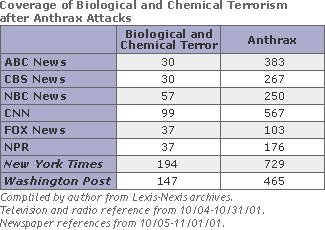 |
|
| During a story about the anthrax threat, CNN showed images of contaminated envelopes addressed to NBC news anchor Tom Brokaw and Senator Tom Daschle of South Dakota (October 23, 2001). CNN ImageSource |
|
With all this media coverage, the public became scared even before the threat was realized. Once the first case was known, we saw tremendous news coverage. Hundreds of stories were published and broadcast. Again, the coverage in the print press was even greater than that by television and radio news organizations. The accompanying table details the number of individual anthrax stories. To me, this kind of coverage indicates that the media were waiting for the second shoe to drop; they were waiting for the next, more terrible kind of terrorism to occur. Once the fear became reality and a man in Florida contracted the first case of anthrax, the news coverage of this new terrorist threat became even greater.
 |
|
The media overcovered the threat of biological or chemical weapons even before the first case of anthrax had been revealed. |
|
The concern about overcoverage arose not only from people outside the media. A few members of the media also recognized that the coverage of the biological-terrorist threat had gotten out of hand. Robert Samuelson, a political columnist for the Washington Post, wrote in his November 7 column that the greatest danger for journalism was that "our new obsession with terrorism will make us its unwitting accomplices." Samuelson was afraid the journalists would become "merchants of fear." He noted that the overcoverage of anthrax exemplified how a relatively minor threat to the public could be escalated by the media. I think Samuelson really hit on something important. He saw that by relentlessly publicizing the story the media had made the threat much greater than it actually was:
 |
I don't think one can make this point much more clearly than Samuelson did in his column. Unfortunately, not many people in the media heeded his advice.
 |
|